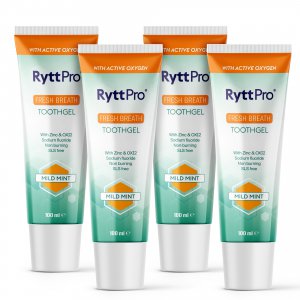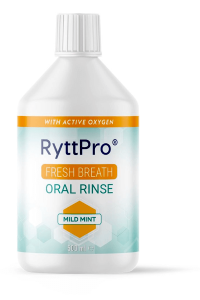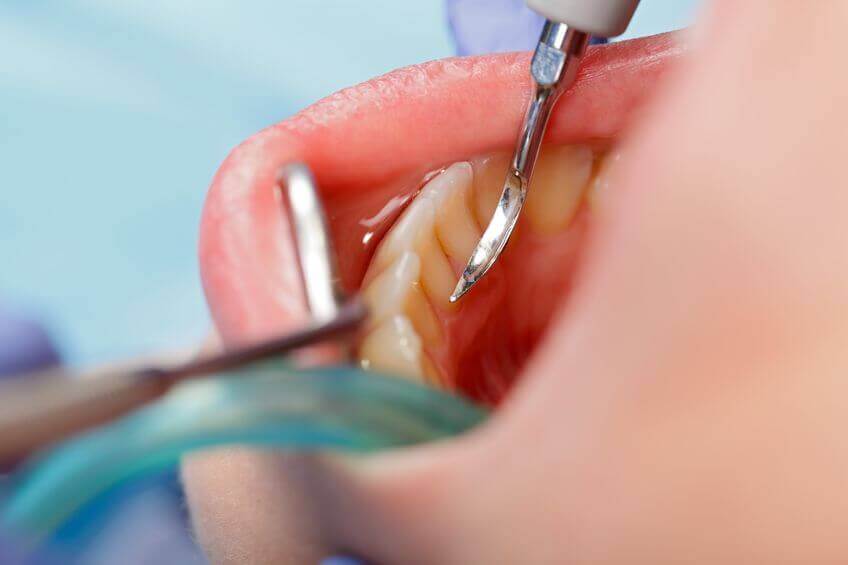Author: Lizzie Smith – blog last updated on Friday 23rd June 2023.
What can you do to prevent tartar? Once tartar has formed, getting it off your teeth isn’t easy. Tartar can lead to gingivitis (gum inflammation), caries (cavities) and, if neglected, periodontitis (deterioration of the tissues around the teeth) and eventually even bone breakdown, causing teeth to become loose and fall out.
More than enough reasons to do everything possible to prevent tartar, right? To remove tartar, you need to remove dental plaque, which is easy. However, most people will still have some tartar deposits. So be alert and start removing tartar yourself.
Below are 10 useful tips to help you prevent or remove tartar:
Tip 1: Brush with an anti-tartar toothpaste

By brushing your teeth twice daily, you’re removing the layer of plaque that’s formed. Electric and sonic toothbrushes appear more effective at removing plaque than manual toothbrushes. However, the most important thing is that you brush carefully. Brush for at least two minutes and place the brush at a 45-degree angle to the gum line. The technique also depends on whether you use an electric, sonic or manual toothbrush. If necessary, ask your dentist or dental hygienist for guidance.
As you have to brush anyway, why not use a toothpaste that fights the harmful bacteria that form dental plaque? But use one that doesn’t contain aggressive or acidifying ingredients that disturb the natural balance of your oral flora. Because, in the long run, this will only lead to more tartar.
RyttPro Toothpaste Magic Mint is a great anti-tartar toothpaste that meets these conditions. The active formula OZ-3X removes dental plaque effectively and is safe and mouth-friendly.
Tip 2: Flossing or brushing
Plaque can easily accumulate between the teeth because your toothbrush won’t reach there. You should thoroughly clean these interdental spaces daily. You can do this with dental floss, toothpicks and/or tooth cleaners (interdental brushes). Choose the size carefully with the latter option because too small won’t clean properly, and too large will damage your gums. Don’t forget the back of your back molars; this is also an area where tartar forms easily.
Tip 3: Use an anti-tartar mouthwash
After brushing and flossing or brushing your teeth, use a mouthwash to wash away the last remnants of dental plaque. As with brushing and flossing, it’s best to do this every night before bed, so you don’t give the remaining plaque a chance to turn into tartar while you sleep.
 As with toothpaste, pay attention to the ingredients of mouthwash. Avoid mouthwashes containing alcohol, SLS (sodium lauryl sulfate) and unnecessary dyes. RyttPro Oral Rinse is a mild mouthwash that prevents dental plaque and tartar. It includes the powerful formula OZ-3X.
As with toothpaste, pay attention to the ingredients of mouthwash. Avoid mouthwashes containing alcohol, SLS (sodium lauryl sulfate) and unnecessary dyes. RyttPro Oral Rinse is a mild mouthwash that prevents dental plaque and tartar. It includes the powerful formula OZ-3X.
Tip 4: Eat healthy food
A varied and balanced diet is beneficial for your overall health. But it’s also great for your oral health. Eat sufficient fruit, vegetables, whole-grain products daily, legumes every week, and a few eggs, preferably oily fish and unprocessed white meat, such as chicken. Avoid junk foods that are high in carbohydrates and foods containing sugar.
Carbohydrates and sugar also have a direct stimulating effect on the formation of dental plaque and tartar. It’s food for the harmful bacteria in your mouth, which they convert into acids. This affects the tooth enamel, making the teeth rougher and causing caries (cavities).
Tip 5: Limit the number of times you eat each day
It’s not only what you eat but how often you eat that affects the formation of tartar. Dental plaque is a mixture of mucus, bacteria and the food particles that the bacteria feed on. The less food in your mouth, the less nutrition the bacteria get. Also, make it a habit to rinse your mouth with water or mouthwash after a meal. Doing so will rinse away any food residues and bacteria (the early stages of dental plaque). It’s also a good idea to rinse your mouth after eating fruit or drinking a sweet drink.
Tip 6: Use a dental care chewing gum

In between brushing your teeth, you can remove dental plaque with a healthy chewing gum containing xylitol. This also stimulates the salivary glands and saliva, helping to keep your mouth healthy and eliminating the bacteria. With Moist-R Hydrating Chewing Gum, you’ll not only freshen your breath during the day but also protect your teeth and care for your gums at the same time. If you don’t like chewing gum, opt for Moist-R Xylitol tablets for Dry Mouth.
Tip 7: Pay attention to dry mouth complaints
As indicated in tip 6, sufficient saliva is vital for oral health. If you have too little saliva for whatever reason, pay attention to it. With Moist-R Moisturizing Mouthspray and the chewing gum or tablets mentioned above, you can make up for the lack of saliva and, at the same time, stimulate your salivary glands.
Tip 8: Sticky tell-tales
If you’re not entirely sure you’re brushing all the plaque from your teeth, you can check this by using a plaque detector. After brushing, it turns the remaining dental plaque pink or blue, so you know you need to brush even better in those places. Many plaque detectors even differentiate between old and new plaque by using two different colours.
Tip 9: Be alert to the beginnings of tartar
No matter how well you remove plaque, most people will still have some tartar. Amongst other things, this is to do with the minerals, such as calcium, in your saliva. The sooner you remove the first signs of tartar, the less it can grow further.

You can safely remove supra-gingival (visible) tartar with the Moist-R Whitening Sponge. This soft sponge cleans your tooth enamel at a deep level through nano-capillary tubes when it comes into contact with water. Or you can use the traditional Profi dental hook, a set of 2 dental hooks and a mouth mirror. You’ll need a steady hand to do this, so you don’t damage your gums.
Tip 10: Visit your dentist and dental hygienist regularly
Although using the above top tips, you can do a lot yourself to prevent and remove tartar; you can’t completely avoid visits to your dental care professionals. For example, to check for sub-gingival tartar that’s grown under the gums. Regular dental cleaning by a dentist or dental hygienist prevents severe tartar buildup and associated problems such as gum infections and tooth decay. Ignoring the problem can lead to higher treatment costs.
Sources
British Dental Association: Myth busters on brushing your teeth
British Dental Journal: Time to take gum disease seriously

